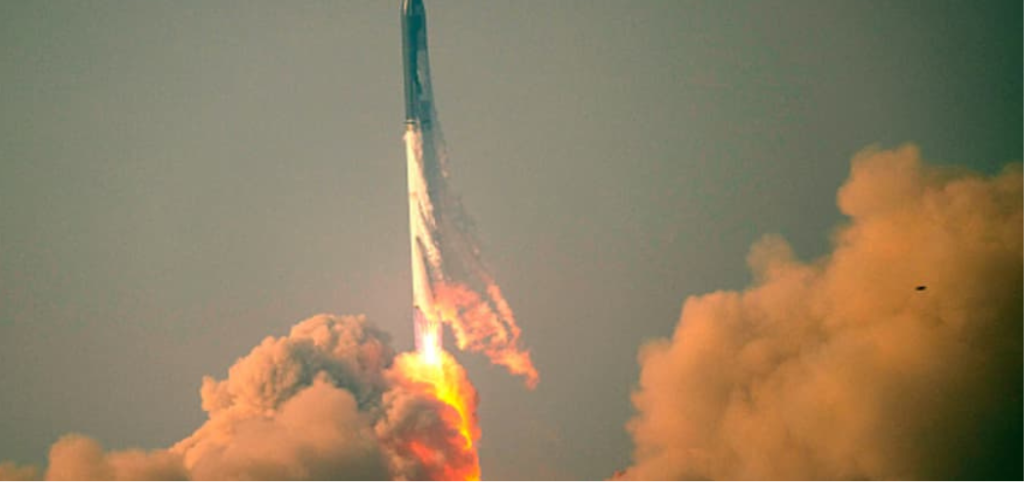SpaceX’s colossal Super Heavy-Starship rocket, the most powerful ever constructed, embarked on its third test flight this Thursday morning, successfully propelling the unmanned upper stage into space. Although both stages fragmented during separate descents into ocean splashdowns, company officials lauded the flight as a significant advancement.
Breathtaking live footage from a camera affixed to one of the Starship’s fins displayed the intense red glow of re-entry heating as the spacecraft descended into the lower atmosphere, intensifying until the Starship was enveloped in a dazzling fireball. Insulation tiles on its underside endured temperatures exceeding 2,500 degrees.
Telemetry ceased at an altitude of approximately 40 miles, indicating the Starship disintegrated before executing a rocket-powered descent to a destructive splashdown in the Indian Ocean. Nonetheless, completing the journey from launch to space and enduring peak heating upon re-entry was deemed a notable achievement by the company.
“Today has been an exceptional day,” remarked a SpaceX commentator.
However, the Federal Aviation Administration classified the loss of both stages as a “mishap” and stated that the agency “will oversee the SpaceX-led mishap investigation.”
The test flight commenced at 9:25 a.m. EDT when the massive rocket’s 33 Raptor engines roared to life, consuming 40,000 pounds of liquid oxygen and methane propellants per second, creating a ground-shaking roar.
Within moments, the 394-foot-tall rocket began its ascent, piercing through clouds of dust and steam created by the booster’s fiery exhaust, which vaporized water sprayed upward at the base of the pad to mitigate the shock of engine ignition.
As it smoothly accelerated, consuming propellants and shedding weight, the Super Heavy-Starship veered eastward over the Gulf of Mexico, captivating thousands of onlookers, including residents, tourists, and journalists observing from the launch site and nearby South Padre Island.
All 33 Raptors functioned as expected, propelling the rocket beyond the region of maximum aerodynamic stress as it accelerated past the speed of sound and ascended out of the dense lower atmosphere.
Two minutes and 42 seconds post liftoff, the Raptors began shutting down as planned, followed by the ignition of the Starship upper stage’s six engines while still attached to the booster, a recent innovation known as “hot staging.” Subsequently, the Super Heavy and Starship stages separated cleanly.
While the Starship continued its ascent into space, the booster reoriented itself and commenced its descent toward the shore for splashdown. Most of the descent proceeded smoothly, with engines firing as required to decelerate.
However, as it approached the Gulf and passed through low cloud cover, the Super Heavy began oscillating widely as it struggled to maintain its orientation. At this juncture, camera feeds from the spacecraft were lost, and the booster experienced a “hard splashdown” without the planned engine firing for a landing burn.
Meanwhile, the Starship completed its climb to space flawlessly. Its Raptors shut down eight-and-a-half minutes after liftoff, transmitting stunning views of space and Earth’s limb while flight controllers conducted tests. Re-entry commenced approximately 40 minutes later.
SpaceX’s Response to Challenges from Previous Super Heavy-Starship Test Flights

In the past, SpaceX’s attempts at testing the Starship rocket ended dramatically, with both flights concluding in fiery destruction. The first incident occurred in April due to engine shutdowns and a stage separation glitch, while the second, in November, ended just before the Starship was supposed to begin a loop around Earth for a splashdown.
Learning from these setbacks, SpaceX engineers made several modifications, enhancing the rocket’s self-destruct system, refining engine performance, and fortifying the launch pad with a powerful water deluge system to dampen the acoustic shock of engine ignition. They also introduced the “hot staging” technique, igniting the Starship’s engines while still attached to the Super Heavy booster, a method long used by Russian Soyuz rockets to facilitate smoother stage separation.
SpaceX emphasized its iterative development approach, leveraging data from each test to swiftly refine Starship’s design. The third test flight aimed to repeat the primary objectives of sending the Starship into space for a sub-orbital flight and rapid re-entry, with controlled landings planned for both stages – the Super Heavy in the Gulf of Mexico and the Starship in the Indian Ocean.
While SpaceX has successfully recovered and reused smaller Falcon 9 boosters, the Starship faces a different challenge. Unlike its predecessors, no Starship has attempted re-entry from space, exposing its insulating tiles to extreme temperatures exceeding 2,500 degrees Fahrenheit.
Although recovery wasn’t planned for this test flight, both stages were intended to simulate landing procedures before breaking up and sinking upon ocean impact. While this didn’t unfold precisely as expected, significant progress was made. During the Starship’s descent, flight controllers tested a payload door for future Starlink satellite launches.
Of particular importance to NASA was the successful transfer of cryogenic propellants in space and the first-ever restart of a Raptor engine outside the atmosphere. These achievements are crucial for NASA’s Artemis moon program, for which SpaceX is developing a variant of the Starship to serve as the Human Landing System (HLS). The HLS will necessitate automated refueling in Earth orbit before embarking on lunar missions, requiring multiple Super Heavy-Starship tankers to facilitate the journey.
With up to 10 refueling flights required for a single HLS mission to the moon, these milestones mark significant progress towards achieving NASA’s ambitious goals for lunar exploration.
The Epic Journey of the Largest Rocket Humanity Has Ever Seen
The Super Heavy-Starship, affectionately known as “Starship,” represents a potential revolution in space travel. Standing at an impressive 39 stories tall and boasting SpaceX’s powerful Raptor engines, this colossal rocket generates over 16 million pounds of thrust, doubling the power of NASA’s iconic Saturn 5 rocket.
Comprised of the towering Super Heavy first stage and the versatile Starship upper stage, equipped with its own set of Raptor engines, this spacecraft is designed for reusability and adaptability. The Super Heavy is engineered to return to its launch pad autonomously, while the Starship can navigate itself to various landing sites, including the moon and, in the future, Mars.
Despite its promise, Starship’s journey has been fraught with challenges. Its maiden flight in April faced multiple engine failures and issues with stage separation, resulting in a dramatic self-destruct sequence just four minutes after liftoff. A subsequent test flight in November saw the Super Heavy booster perform as expected, but a catastrophic explosion occurred shortly after its turnaround for splashdown.
The success of the Super Heavy-Starship is pivotal for NASA’s Artemis moon program. With a contract awarded to SpaceX to develop a variant of the Starship for lunar missions, NASA aims for an unpiloted lunar landing test flight before astronauts attempt a manned landing, targeted for late 2026. However, NASA insists on a rigorous series of successful flights before deeming the spacecraft safe for human travel.
As SpaceX continues its iterative approach of frequent testing and learning from failures, the hope is to establish the reliability necessary to fulfill NASA’s lunar exploration goals. This collaboration between SpaceX and NASA marks an exciting chapter in space exploration, with the potential to unlock new possibilities for humanity’s journey beyond Earth.
